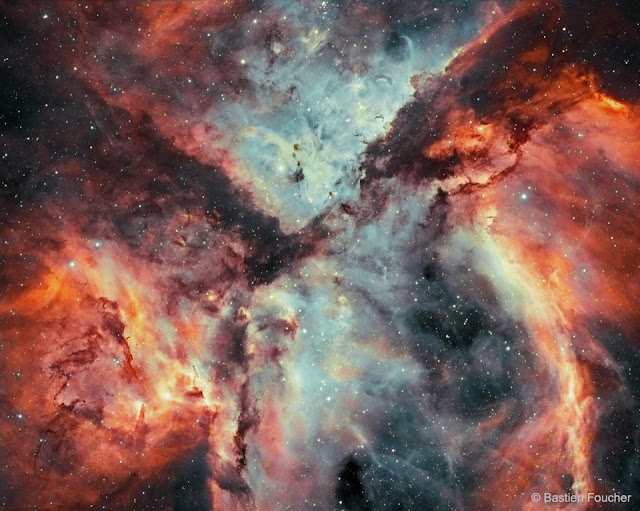Astronomia, astrofísica, astrogeologia, astrobiologia, astrogeografia. O macro Universo em geral, deixando de lado os assuntos mundanos. Um olhar para o sublime Universo que existe além da Terra e transcende nossas brevíssimas vidas. Astronomy astrophysics, astrogeology, astrobiology, astrogeography. The macro Universe in general, putting aside mundane subjects. A look at the sublime Universe that exists beyond Earth and transcends our rather brief life spans.
Pesquisar conteúdo deste blog
sexta-feira, 25 de agosto de 2017
Stars, Gas, and Dust Battle in the Carina Nebula | Estrelas, gas, e poeira batalham na Nebulosa de Carina
Reina o caos na Nebulosa de Carina, onde grandes estrelas se formam e morrem. Impressionante e detalhado, este close-up de uma porção da famosa nebulosa é uma combinação de luz emitida por hidrogenio (mostrada em vermelho) e oxigenio (mostrada em azul).
Dramatic nós de poeira escura e complexos detalhes revelados são esculpidos pelos ventos e radiação das grandes e energeticas estrelas de Carina.uma caracteristica tipica da Nebulosa de Carina é a trilha de poeira escura em formato de V que ocorre na metade superior da imagem.
A Nebulosa de Carina espalha-se por uns 200 anos-luz, situada à distancia de 7.500 anos-luz, sendo visivel atraves de binoculos na direção da constelação de Carina, no sul. Um bilhão de anos depois que a poeira baixar — ou tudo for destruido, e o gas se dissipar — ou condensar-se gravitacionalmente, só restarão as estrelas — mas nem mesmo as mais brilhantes.
Tradução de Luiz M. Leitão da Cunha
Chaos reigns in the Carina Nebula where massive stars form and die. Striking and detailed, this close-up of a portion of the famous nebula is a combination of light emitted by hydrogen (shown in red) and oxygen (shown in blue).
Dramatic dark dust knots and complex features revealed are sculpted by the winds and radiation of Carina's massive and energetic stars. One iconic feature of the Carina Nebula is the dark V-shaped dust lane that occurs in the top half of the image.
The Carina Nebula spans about 200 light years, lies about 7,500 light years distant, and is visible with binoculars toward the southern constellation of Carina. In a billion years after the dust settles -- or is destroyed, and the gas dissipates — or gravitationally condenses, then only the stars will remain — but not even the brightest ones.
Assinar:
Postar comentários (Atom)

Nenhum comentário:
Postar um comentário